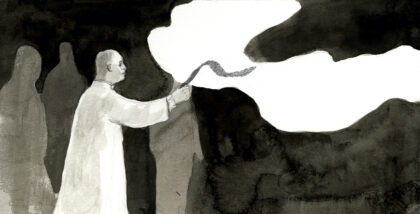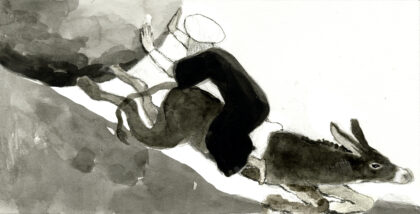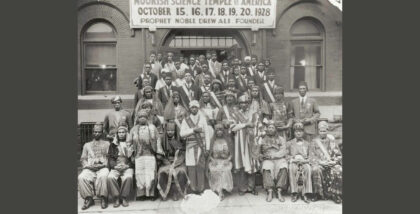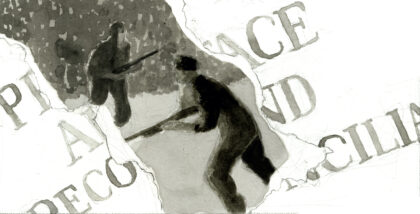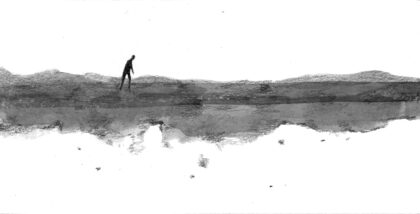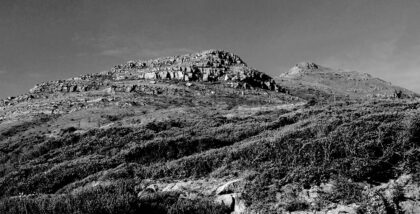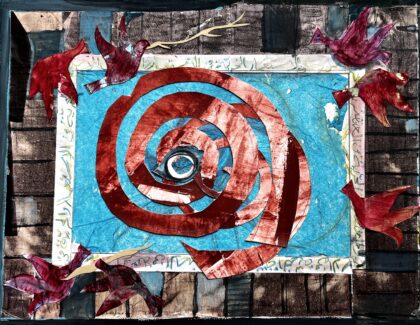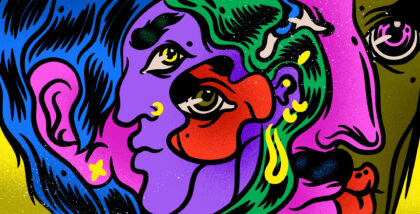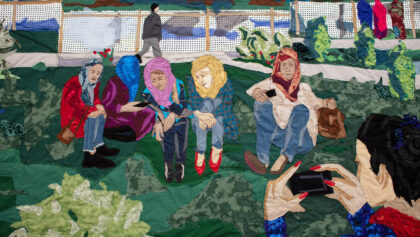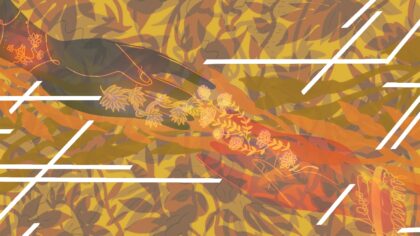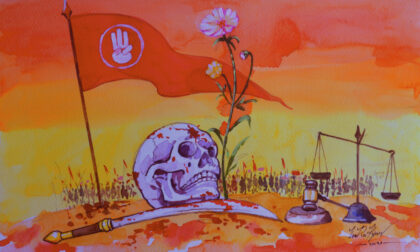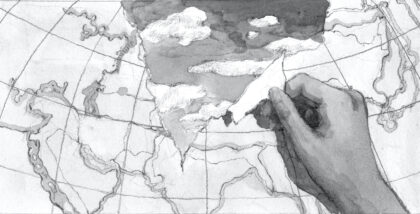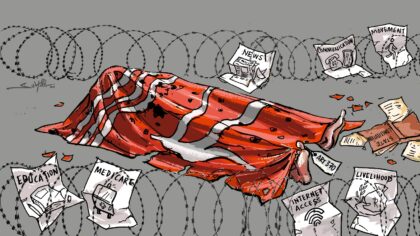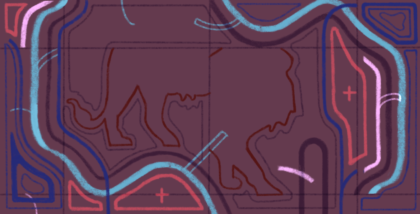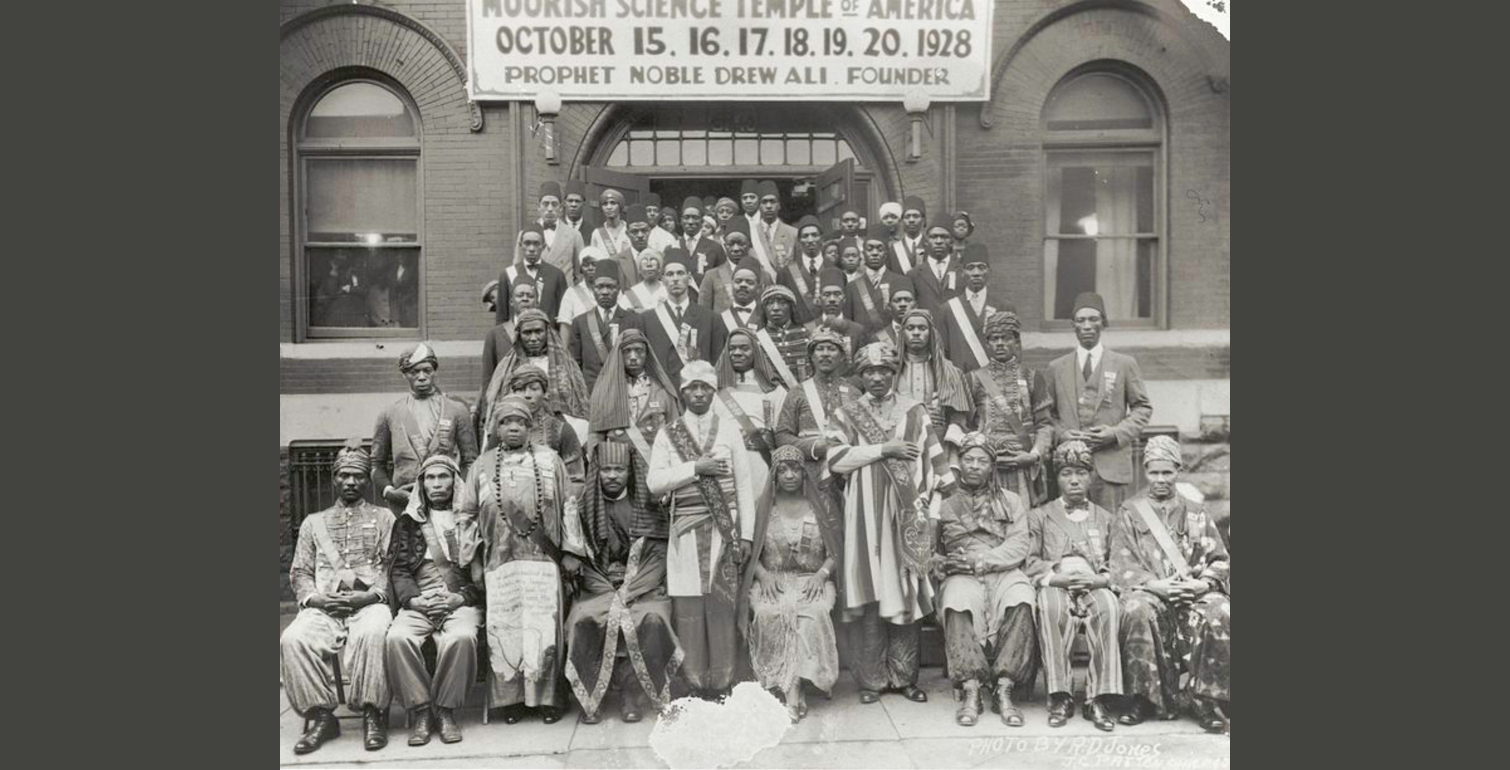 A photo of the 1928 Moorish Science Temple Conclave in Chicago, Illinois.
A photo of the 1928 Moorish Science Temple Conclave in Chicago, Illinois.
“I am given to understand that whiteness is ownership of the earth forever and ever, Amen! Now what is the effect on a man or a nation when it comes passionately to believe such an extraordinary dictum as this? That nations are coming to believe it is manifest daily.”
—W.E.B. Du Bois
In American news media and entertainment, terrorism is primarily imagined as a matter of violence: bodies, bombs, metal, and fire. Often, this understanding of violence is extended to include physical damage to property in addition to killing or injuring people. This appears to be how “eco-terrorists” who commit arson or bomb buildings can be considered violent, despite no people being physically harmed. But while violence is popularly perceived as an essential component of any definition of terrorism, the state does not see it that way. Indeed, some of what the state labels as terrorism, it also labels as nonviolent.
The seemingly paradoxical notion of nonviolent terrorism, which surfaces primarily in the US context, presents an opportunity to consider not only how terrorism becomes the basis for war, but what such a war is for. What is being defended, or what is at stake? If terrorism can be nonviolent, then what makes it a problem in the first place?
To explore these concerns, I focus here on a close reading of the FBI’s now notorious “Black Identity Extremism” report, which shows that entanglements of terrorism circle not only around questions of defense against violence, but around questions of ownership.
*
The FBI Domestic Terrorism Analysis Unit’s report on “Black Identity Extremists” was leaked and published by Foreign Policy in 2017, thus introducing the phrase to the public. The report was rightly criticized as being directed at the Movement for Black Lives, which is not named but is signaled by references to Michael Brown’s murder in Ferguson, Missouri. The report defines BIEs as those who use violence in their fight against racism, a fight that involves seeking some kind of separation or autonomy based on religious or political beliefs.
The report traces BIE back to the early 20th century, to the first Muslim organization in the US, the Moorish Science Temple of America (MSTA). Described as “a non-violent religious and cultural movement,” the MSTA is footnoted as a source from which one category of Black identity extremist, called “Moorish sovereign citizens,” takes shape.
The genealogy of BIE then jumps 50 years ahead to the 1960s and 1970s, when “BIE violence peaked” with the Black Liberation Army (featured prominently in the main body of the report). The BLA took “up arms for the liberation and self-determination of Black people in the United States,” and was involved in “at least 38 criminal incidents.” The BLA understood Black people in this country as a colonized population with the right to self-determination. This meant the right to self-defense against the police, understood as a colonial, occupying military force. Assata Shakur is among its most well-known former members. She was sent to prison for allegedly killing a police officer, and escaped in 1979, gaining political asylum in Cuba. Often quoted by the Movement for Black Lives, she is currently on the FBI’s most wanted terrorist list.
The report’s history continues and notes that the ’90s until 2014 was a cool period of sorts, when BIEs “had not targeted law enforcement with premeditated violence.” The 2014 Ferguson protests marked a “resurgence” of BIEs, evidenced in six subsequent cases of BIEs killing or injuring law enforcement officers. Four of these involved “Moorish sovereign citizen extremist (SCE) ideology, a category of SCE ideology.” The report warns that BIE violence against law enforcement is likely in the coming years.
The FBI’s genealogy of its BIE concept illuminates some of the deeper meanings of ownership in the context of domestic terrorism. It shows that the threat of Black identity extremism is not simply the threat of a proud or strong Black identity. Indeed, the state itself is able to celebrate Black pride on occasion. As former BLA member Dhoruba bin Wahad has pointed out, what puts the identity in Black identity extremism is the threat of Black self-determination: “The fear is not against the identity politics. It’s the fear that we will transform that identity politics into legal control of those mechanisms of oppression and suppression that are currently occupying our community,” particularly the police—the protectors of property ownership rights in the US since their inception. His explanation is well-supported by the FBI’s overwhelming concern for the physical safety as well as the legitimacy of law enforcement in the BIE document, which is not only a question of violence against police but also a fear that what the police represent will be delegitimized.
Black self-determination is a direct challenge to the property relations that police protect, whether materially or symbolically.
The police emerged unevenly in the US over the nineteenth century. In the North, they policed labor strikes, and in the South, they captured escaped slaves. But the police in both cases were guided by a concern with protecting a particular arrangement of labor, capital, and property—in short, ownership. Contemporary policing continues in this vein. The legitimacy of police, then, is tied to the legitimacy of a certain economic arrangement in which Black people are ownable in any given way.
Black self-determination is a direct challenge to the property relations that police protect, whether materially or symbolically. It is a challenge to whatever renders Black people as owned or ownable, which is sustained by more than police violence. Along similar lines, the bureau also feels threatened by Black identity practices it names as nonviolent, which demonstrates that violence is not the primary concern for the FBI when it comes to Black politics. Rather, the concern is preserving the terms of ownership.
The identity practices of the MSTA dominate the report’s long footnote on the movement. It begins, “Moorish sovereign citizen ideology derives from the Moorish Science Temple of America, a non-violent religious and cultural movement founded in 1913 by Nobel (sic) Drew Ali.” Noble Drew Ali “taught his followers they were not ‘negroes’ but Moors, people of North African Berber and Arab descent,” the report reads.
The significance of that teaching runs deep. The Negro was a fabricated identity attached to some Africans for chattel slavery. It is an identity as property. By definition, property is owned and lacks autonomy, sovereignty, and self-determination. “Negro” corresponded to the geographic/historic vision of the US racial order and its property arrangements, in which freedom was defined by the capacity to own.
The Black movements and organizations here are very different from one another in ideology, practices, and goals, and again, they are not categorized as extremist based on violence. The deeper issue of ownership is made even clearer if we turn to what makes the 2017 BIE report distinctive to begin with.
*
Critics of BIE have rightly noted that the report’s casting of Black politics as extremism or terrorism is not new. The FBI has surveilled Black political and religious activity as a national security matter since the early twentieth century. What is new, or more accurately distinctive, about this report, then, is the connections it makes between very different movements, collapsing violent and nonviolent groups as well as Black and white groups under a rubric of counter-extremism. The report claims to be the “first FBI analytic intelligence product to assess influences between the sovereign citizen extremist movement and the Black identity extremist movement.” Notably, sovereign citizens are mostly white supremacists, and their tactics are mostly nonviolent.
The sovereign citizen movement is a very loosely organized network of people, lacking established leadership or much of a group structure. According to the FBI, which regards them as a domestic terrorism movement, their core belief is that the US government is illegitimate and does not have sovereignty over them. The movement is typically traced back to the early 1980s and tends to attract white supremacists. The director of the Center for the Study of Hate and Extremism at California State University in San Bernardino has said, “Most of them are not going to do anything but bore their relatives and friends with ridiculous papers and treatises.” The phrase “conspiracy theories” comes up a lot in literature about their ideology, and more recently, QAnon has borrowed from sovereign citizen ideology.
Between QAnon involvement in the January 6th Capitol incident and several earlier cases of sovereign citizens shooting police officers, questions of violence, particularly against law enforcement (defenders of US sovereignty), remain close by. Terry Nichols of the Oklahoma City bombing is one well-known sovereign citizen. However, it is critical to note that such violence does not make them terrorists in the eyes of the state; rather, their nonviolent financial crimes do. Their primary tactic is called “paper terrorism,” which includes money laundering, tax evasion, and creating fraudulent checks, invoices, liens, and other financial documents.
The state recognizes these as nonviolent tactics of domestic terrorism. At stake here is a question of ownership: the sovereign citizen movement is framed as a threat to national security—understood as the legitimacy of the nation—especially when their nonviolent financial crimes are accompanied by politics that reject the terms of ownership around which the state is designed.
In a US settler vision of the world, indigenous land and those called “Negroes” are owned, naturally distinct from one another, and naturally suited to specific purposes for European interests.
The FBI collapses sovereign citizens’ rejection of US sovereignty with Black politics. This collapse is not incidental to the report, but central. The report claims to be the first such report to make this connection. What is the nature of the connection? We can rule out race, at least in an identity sense, since sovereign citizens and so-called BIEs do not share a racial identity. What they share is some connection to ownership, which lies at the heart of Du Bois’s definition of whiteness.
For the FBI, the MSTA is a kind of ideological glue between sovereign citizens and Blackness. The FBI’s issue with the MSTA illustrates how this connection is made between otherwise very different movements and politics. The MSTA emerged in a time when the role of white Christianity in Black America was being collectively interrogated, and Black people explored ways in which they were not defined by America alone, or at all. For the MSTA, those called Negro/colored/Black are actually Asiatic or Moorish, which is also to say indigenous, and the natural religion for such a people is Islam.
In contrast, in a US settler vision of the world, indigenous land and those called “Negroes” are owned, naturally distinct from one another, and naturally suited to specific purposes for European interests. Noble Drew Ali’s geographic/historic vision, then, cast suspicion upon the geographic/historic narratives that backed a US settler mindset. Noble Drew Ali and his followers carried nationality cards asserting both Moorish-American nationality and, equally significantly, US citizenship. Their nationality cards were not a legal or quasi-legal rejection of US citizenship or sovereignty per se, but a rejection of what that US sovereignty meant for them racially and religiously.
The BIE report situates MSTA practices as a historical precedent for sovereign citizen ideology: “Some Moorish adherents adopt sovereign citizen strategies to assert diplomatic immunity by claiming membership in fictitious Native American tribes, claiming descent from settlers who arrived in North America during the pre-Columbian era, or identifying as foreign nationals or ambassadors.” The FBI’s discussion of the MSTA suggests that violence is not what places the MSTA in a genealogy of domestic terrorism, as it is named as a nonviolent group. Instead, the autonomous nature of their self-identities, away from being property, is what puts them under the rubric of domestic terrorism. That autonomy is based on a worldview that pushes Europeans out of their assumed position as the natural rulers of the world who fashioned people as owned/ownable through identities like “Negro.”
The other side of this identity is whiteness, which is ownership, as Du Bois makes so clear. These racial identities are materially sutured to notions of property and ownership that law enforcement, specifically domestic counterterrorism in this case, is tasked with maintaining.
*
At least two counterintuitive points arise in this essay. While many think terrorism is defined by violence, the state—the entity that prosecutes terrorism—counts some nonviolent activities as terrorism. Further, many think that “Black” and “white” are always different, even if they recognize that much of the difference is constructed. But for the state, it is sometimes more useful to not construct them as very different from one another.
The story here is not about identifying race differences and disparities in counterterrorism, but how race differences are folded together and collapsed into counterterrorism in ways that naturalize and preserve the terms of ownership that domestic counterterrorism protects.
The latest chapter in the story of BIE continues in this direction: in 2019, after being critiqued by civil rights organizations and some legislators, the FBI stopped using this label. The bureau recategorized the content of BIE into an umbrella category called “racially motivated extremism,” which also includes “white supremacist extremism.” This distorted equality of Black and white can rhetorically protect the state from certain direct charges of racism while also not veering from the central property/sovereignty concern that animates domestic counterterrorism.
*
There is a temptation to believe that “terrorism” is a matter of violence, always. It allows a tidy moral righteousness for wars against terrorism, domestic and global. But even a brief look at domestic terrorism and the complicated issues it unravels suggests that domestic counterterrorism is not centrally concerned with stopping violence.
Rather, what all of the above movements, organizations, violent and nonviolent tactics, and wildly different politics all have in common—what they all seem to share under the rubric of “domestic terrorism”—is that they are a challenge to the legitimacy of a particular arrangement of US sovereignty and property relations.
The terrorism designation has a strong gravitational pull that can obliterate anything near its orbit.
Domestic counterterrorism protects US sovereignty and its private property arrangements, materially and symbolically, violently and nonviolently. This includes the settler-colonial structure of US sovereignty. Paper is one medium in which sovereignty and self-determination claims are made and contested. Terrorism can then come in the form of paper as well.
Although they all have something to do with property and sovereignty, these Black, white, left, and right movements are not equally subject to the violence of the property arrangement they challenge. And of course, Black, indigenous, and white nationalist relationships to property and sovereignty are far from identical to one another. Some are in direct conflict. “Black identity extremism,” for example, is characterized by Black people seeking autonomy outside of the racial property relation that law enforcement emerged to maintain. As for white supremacists or nationalists who are characterized as domestic terrorists, they seek a different articulation of US sovereignty under more blatantly racist terms. It is a project of restoration, for some, as the MAGA slogan shows quite plainly. Some white nationalists are responding to an expansion of the racial boundaries over the past few decades that determine who can be an owner, and they want to restore a white monopoly over ownership, forever and ever, Amen. Others welcome a multiracial membership in their Western chauvinism, which is, again, defined by ownership.
The terrorism designation has a strong gravitational pull that can obliterate anything near its orbit. This is an obstacle to the work of asking deeper political and economic questions about the very basic set-up of our society and who it serves. Domestic terrorism may be better understood as a matter of property, sovereignty, labor, and capital. Of course, these are saturated in violence. However, a reorientation from questions of violence to questions of ownership is productive. It clears the ground of deliberately muddy rhetoric about violence and brings the real stakes of counterterrorism—resources and distribution—into our line of vision. It reveals how, far from being an exotic problem, counterterrorism shares roots with other ongoing crises.
